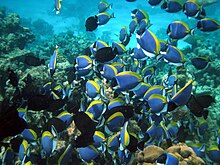Acanthurus leucosternon
| Acanthurus leucosternon | |
|---|---|

| |
| Scientific classification | |
| Domain: | Eukaryota |
| Kingdom: | Animalia |
| Phylum: | Chordata |
| Class: | Actinopterygii |
| Order: | Acanthuriformes |
| Family: | Acanthuridae |
| Genus: | Acanthurus |
| Species: | A. leucosternon
|
| Binomial name | |
| Acanthurus leucosternon E. T. Bennett, 1833
| |
| Synonyms[2] | |
| |
Acanthurus leucosternon, commonly known as the blue surgeonfish, powder blue tang or powder-blue surgeonfish, is a species of marine
Taxonomy
Acanthurus leucosternon was first formally
Etymology
Acanthurus leucosternon has the specific name leucosternon. This combines the Greek words leukos, meaning "white", and sternon, meaning "breast"; this refers to the white chest shown by this species.[5]
Description
The fish can reach an average size of 23 cm (9 in) in length.
Distribution and habitat
Acanthurus leucosternon is found in tropical waters from the Indian Ocean.[10] The species inhabits shallow and clear coastal waters always associated with a reef. It prefers flat top reefs and areas along seaward slopes.[10]
Behaviour
The powder blue tang, like most
Economic value

The powder blue tang is rarely harvested for anything other than the marine
References
- . Retrieved 27 December 2021.
- ^ a b Froese, Rainer; Pauly, Daniel (eds.) (2023). "Acanthurus leocosternon" in FishBase. June 2023 version.
- ^ Eschmeyer, William N.; Fricke, Ron & van der Laan, Richard (eds.). "Species in the genus Acanthurus". Catalog of Fishes. California Academy of Sciences. Retrieved 18 September 2023.
- ISBN 978-1-118-34233-6.
- ^ Christopher Scharpf & Kenneth J. Lazara, eds. (12 January 2021). "Order ACANTHURIFORMES (part 2): Families EPHIPPIDAE, LEIOGNATHIDAE, SCATOPHAGIDAE, ANTIGONIIDAE, SIGANIDAE, CAPROIDAE, LUVARIDAE, ZANCLIDAE and ACANTHURIDAE". The ETYFish Project Fish Name Etymology Database. Christopher Scharpf and Kenneth J. Lazara. Retrieved 7 September 2023.
- ^ ISBN 0-7641-3256-3.
- ^ Clipperton, John (1 September 2013). "Powder Blue Tang – Acanthurus leucosternon". Marine Habitat magazine. Fish Junkies Ltd. Archived from the original on 14 February 2014. Retrieved 13 February 2014.
- ^ ISBN 978-0-7566-8886-8.
- ISBN 2711415252), p. 366
- ^ a b "Facts about Powder Blue Tang (Acanthurus leucosternon) - Encyclopedia of Life". Eol.org. Retrieved 2014-01-04.
Further reading
- Robertson, Ross; Polunin, Nicholas; Leighton, Kimberley (1979). "The behavioral ecology of three Indian Ocean surgeonfishes (Acanthurus lineutus, A. leucosternon and Zebrusoma scopes): their feeding strategies, and social and mating systems". Environmental Biology of Fishes. 4 (2): 125–170. .
External links
- Tang at Wetwebmedia.com
- Powder Blue Tang
- World Register of Marine Species
- Photos of Acanthurus leucosternon on Sealife Collection

